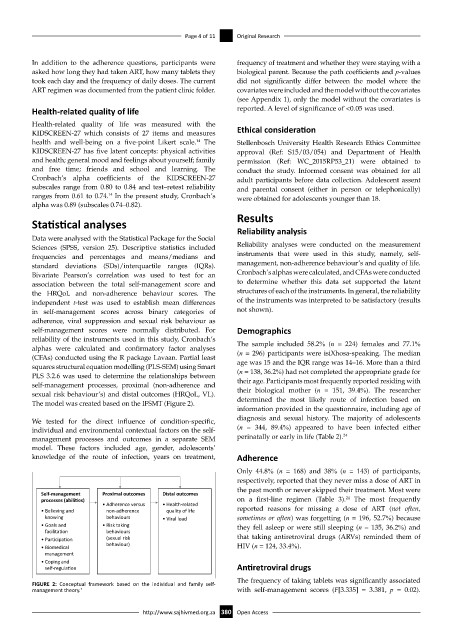Page 388 - HIVMED_v21_i1.indb
P. 388
Page 4 of 11 Original Research
In addition to the adherence questions, participants were frequency of treatment and whether they were staying with a
asked how long they had taken ART, how many tablets they biological parent. Because the path coefficients and p-values
took each day and the frequency of daily doses. The current did not significantly differ between the model where the
ART regimen was documented from the patient clinic folder. covariates were included and the model without the covariates
(see Appendix 1), only the model without the covariates is
Health-related quality of life reported. A level of significance of <0.05 was used.
Health-related quality of life was measured with the
KIDSCREEN-27 which consists of 27 items and measures Ethical consideration
health and well-being on a five-point Likert scale. The Stellenbosch University Health Research Ethics Committee
14
KIDSCREEN-27 has five latent concepts: physical activities approval (Ref: S15/03/054) and Department of Health
and health; general mood and feelings about yourself; family permission (Ref: WC_2015RP53_21) were obtained to
and free time; friends and school and learning. The conduct the study. Informed consent was obtained for all
Cronbach’s alpha coefficients of the KIDSCREEN-27 adult participants before data collection. Adolescent assent
subscales range from 0.80 to 0.84 and test–retest reliability and parental consent (either in person or telephonically)
14
ranges from 0.61 to 0.74. In the present study, Cronbach’s were obtained for adolescents younger than 18.
alpha was 0.89 (subscales 0.74–0.82).
Statistical analyses Results
Reliability analysis
Data were analysed with the Statistical Package for the Social
Sciences (SPSS, version 25). Descriptive statistics included Reliability analyses were conducted on the measurement
frequencies and percentages and means/medians and instruments that were used in this study, namely, self-
standard deviations (SDs)/interquartile ranges (IQRs). management, non-adherence behaviour’s and quality of life.
Bivariate Pearson’s correlation was used to test for an Cronbach’s alphas were calculated, and CFAs were conducted
association between the total self-management score and to determine whether this data set supported the latent
the HRQoL and non-adherence behaviour scores. The structures of each of the instruments. In general, the reliability
independent t-test was used to establish mean differences of the instruments was interpreted to be satisfactory (results
in self-management scores across binary categories of not shown).
adherence, viral suppression and sexual risk behaviour as
self-management scores were normally distributed. For Demographics
reliability of the instruments used in this study, Cronbach’s The sample included 58.2% (n = 224) females and 77.1%
alphas were calculated and confirmatory factor analyses (n = 296) participants were isiXhosa-speaking. The median
(CFAs) conducted using the R package Lavaan. Partial least age was 15 and the IQR range was 14–16. More than a third
squares structural equation modelling (PLS-SEM) using Smart
PLS 3.2.6 was used to determine the relationships between (n = 138, 36.2%) had not completed the appropriate grade for
self-management processes, proximal (non-adherence and their age. Participants most frequently reported residing with
sexual risk behaviour’s) and distal outcomes (HRQoL, VL). their biological mother (n = 151, 39.4%). The researcher
The model was created based on the IFSMT (Figure 2). determined the most likely route of infection based on
information provided in the questionnaire, including age of
diagnosis and sexual history. The majority of adolescents
We tested for the direct influence of condition-specific,
individual and environmental contextual factors on the self- (n = 344, 89.4%) appeared to have been infected either
management processes and outcomes in a separate SEM perinatally or early in life (Table 2). 24
model. These factors included age, gender, adolescents’
knowledge of the route of infection, years on treatment, Adherence
Only 44.8% (n = 168) and 38% (n = 143) of participants,
respectively, reported that they never miss a dose of ART in
the past month or never skipped their treatment. Most were
Self-management Proximal outcomes Distal outcomes
24
processes (abili es) on a first-line regimen (Table 3). The most frequently
• Adherence versus • Health-related
• Believing and non-adherence quality of life reported reasons for missing a dose of ART (not often,
knowing behaviours • Viral load sometimes or often) was forgetting (n = 196, 52.7%) because
• Goals and • Risk taking they fell asleep or were still sleeping (n = 135, 36.2%) and
facilita on behaviours
• Par cipa on (sexual risk that taking antiretroviral drugs (ARVs) reminded them of
• Biomedical behaviour) HIV (n = 124, 33.4%).
management
• Coping and
self-regula on Antiretroviral drugs
The frequency of taking tablets was significantly associated
FIGURE 2: Conceptual framework based on the individual and family self-
management theory. 7 with self-management scores (F[3.335] = 3.381, p = 0.02).
http://www.sajhivmed.org.za 380 Open Access

